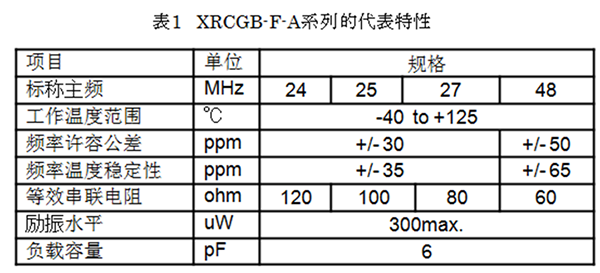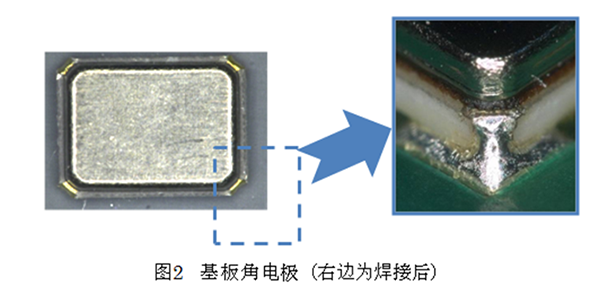1 Introduction
Automotive electronic control, known as the ADAS (Advanced Driver Assistance System) advanced driving support system, has been gradually enlarged in recent years. ADAS uses a camera, millimeter wave, infrared laser, etc., to detect pedestrians or other vehicles and roadsides through proximity sensing of the vehicle and to issue a proximity alarm, and to avoid collision by braking and steering operations to improve driving safety. This type of use is achieved through high-speed and high-precision data processing and the use of clock components with extremely high frequency accuracy. In addition, because it is a safety function, the requirements for high reliability are high.
CERALOCK®, a ceramic resonator for automotive use, has been used for more than 20 years. It is widely used in automotive electrical installations around the world. It is also required for high-application CERALOCK®, small crystal oscillator XRCGB for automobiles. The -FA series has been commercialized. This article will discuss the latest application trends in the car and the required performance of the clock components used in it, and introduce Murata's automotive clock component products.
2. Recent electronics market trends
ADAS has been put into practical use by various functions of various companies. Identify the front roadblock and activate emergency braking, track the vehicle in front, and detect the white line of the road to avoid deviations. In order to achieve the above functions, it is necessary to install a camera (monocular, stereo), a millimeter wave radar (24 GHz band for the 77 GHz band), an infrared laser, an ultrasonic sensor, and the like in the vehicle body. In these sensing devices, a signal processing IC, an RF-IC for receiving and transmitting signals, and the like are mounted, and a clock generator crystal oscillator and an oscillator (SPXO, TCXO, etc.) are also used.
In general, a clock component of ±50 to 100 ppm is required in an image processing IC. In the vehicle environment, the accuracy is in the range of -40 to +125 °C. It is even necessary to meet the reliability test specifications for automotive electronic components, the widely recognized AEC-Q200 (the latest version is Rev_D). The data collected by the sensor is the calculation and judgment inside the IC, and is transmitted to the vehicle control ECU (engine ECU, ESC, EPS, etc.) through the CAN (Controller Area Network).
Recently, Ethernet has attracted attention because it is a communication method for directly transmitting and receiving digital data such as images. Ethernet® is a 100BASE-TX and OPEN Alliance SIG-defined BroadR-Reach standardized by IEEE802.3. Both require clock accuracy of several hundred ppm when communicating, so high-precision clock components are required here. Since these uses pursue high speed and large capacity processing, relatively high frequency products must be used. Image processing is mostly at 24, 27, and 33.33 MHz, and Ethernet® is up to 25 MHz. In addition, radars and the like also require high-frequency clocks such as 30, 40, and 48 MHz.
3. Technical trends of automotive clock components
Electronic components used in automotive applications tend to focus on market performance, and have been much later in the Minsheng market than small-sized ones. The size trend of the crystal oscillator in the livelihood market is gradually decreasing from 3225, while the crystal oscillator for vehicles is used in the standard size of 3225. However, in the in-vehicle market, the latest technology of Minsheng is being actively introduced, and in particular, sensor devices such as cameras and radars are limited in space in a small space, and the circuit is miniaturized from the viewpoint of cost reduction. This demand has been strengthened, so a 2016-sized crystal oscillator is used.
When the crystal oscillator is miniaturized, the crystal element in the package cannot be completely miniaturized as compared with the drop in the package size. The frequency of the oscillator is determined by the size of the crystal element, so the miniaturization of the component is also limited. Therefore, in the miniaturization, the clearance of the relative packaging and the crystal element becomes small, so the difficulty of manufacturing will rise very high. In addition, in the wide temperature range of -40 to +125 ° C in automotive applications, stable electrical characteristics and strong tolerance are sought. For example, when the contact between the component and the package is bonded with a conductive adhesive, the miniaturization relationship causes the bonding area to become small, and the characteristics cannot be ensured. In order to ensure the reliability of adhesion in such an environment, a highly reliable high-conductivity adhesive material and a bonding method are required.
There are many cases in which the vehicle ECU performs the solder fillet inspection after the component is mounted. When the component is miniaturized, the rounded corners are also reduced and it is difficult to recognize. There is a solution to the case where a window electrode for round corner inspection is formed on the side surface of the substrate, and a large electrode cannot be formed due to the limitation of the package size.
It is essential to summarize the problem of miniaturization of crystal oscillators, the production technology of high-precision assembly of small components, the selection of adhesive materials for ensuring high reliability, and the design of a good package for humanized operation. In order to solve this problem, Murata has developed a new small crystal oscillator and started mass production. The details will be explained below.
4. Product specifications and characteristics of the small crystal oscillator XRCGB-FA series for vehicles
The appearance of the XRCGB-FA series is shown in Figure 1. The representative characteristics are shown in Table 1. The frequency corresponds to 24MHz to 48MHz, using the most suitable crystal component design, reducing the frequency tolerance in the car's normal operating temperature (-40 ~ +125 ° C) to a minimum of +/- 35ppm, Ethernet®, etc. The second generation in-vehicle LAN and image processing IC can also correspond. In addition, the load AEC-Q200 also fully corresponds to the RoHS/ELV directive.
The XRCGB-FA series features a non-sealed “Cap Chip†construction in CERALOCK®. Specifically, it is a simple structure in which a metal cap is mounted on a ceramic single-layer substrate and then encapsulated with a resin. The combination of production technology and quality management accumulated with CERALOCK® produces economical and high quality crystal oscillators. The general crystal oscillator is made of a special ceramic package, a highly sealed package (glass package, metal fusion package, etc.). When the package is packaged, moisture remains in the package. The residual moisture inside the product will cause changes in the external temperature. The characteristics are unstable, which is the reason for not vibrating. The XRCGB-FA series eliminates the possibility of characteristic changes by allowing water vapor to permeate through the resin package in the form of molecules, leaving the package dry. That is, the use of this property to discharge minute inorganic foreign matter (metal-based particles). Particles can cause unstimulated conditions, and only elimination can make it possible to ensure a high quality product.


In addition, in order to improve the visibility of the solder fillet, the area of ​​the electrode at the corner of the substrate is enlarged (see Figure 2). Therefore, even the 2016 size can identify the weld fillet.

5. Questions and future research
The performance improvement of the sensing function is changing with each passing day, and the future unmanned driving may not be realized. However, in order to achieve driverlessness, more various sensors and communication connections between the control ECUs are required, and even the development of communication connections (C2X, etc.) outside the vehicle is indispensable. In these communications, clock components with higher precision and higher reliability are indispensable. The clock component division of Murata Manufacturing Co., Ltd. will continue to develop and provide equipment that can contribute to the improvement of vehicle functions.
USB Cable :1.Type A: almost every USB cable has a standard flat rectangular interface at one end. Most computers have a usb-a port to connect to only one USB port.
2.Type-B: almost square connector for printers and other active devices connected to computers. They are not common now because most devices have been moved to smaller connections.
3.Mini USB: a smaller connector type that was standard for mobile devices before micro USB. It's not common today, but you'll see it on some cameras, PlayStation 3 controllers, MP3 players, etc.
4.Micro USB: the current standard for mobile and portable devices, even smaller than Mini USB. Although you can still find micro USB on smartphones, tablets, USB battery packs and game controllers, some have turned to usb-c
5.Type-C: the latest USB standard, which is a reversible cable, promises higher transmission speed and higher power than previous USB types. It can also take into account a variety of functions.
USB Cable
USB Cable
ShenZhen Antenk Electronics Co,Ltd , https://www.antenk.com